Can You Vacuum Glass With A Dyson
This post contains affiliate links. As an Amazon Associate, we earn from qualifying purchases.
You shouldn’t vacuum glass with a Dyson because the sharp shards can damage the machine, leading to issues like torn hoses, clogged filters, or motor damage. For a safer cleanup, use a broom and dustpan for larger pieces and damp paper towels for smaller fragments, while wearing gloves and closed-toe shoes. Stay tuned for more detailed explanations and additional handy tips later in the article.
Essential Facts in 30 Seconds
- Dyson vacuums are not suitable for vacuuming glass due to potential damage.
- Glass shards can clog filters and damage the motor, reducing suction.
- Sharp glass pieces may tear hoses or bags, leading to dirt leakage.
- Vacuuming glass can result in expensive repairs costing over $100.
- A broom and dustpan are recommended for safe glass cleanup.
Understanding the Risks of Vacuuming Glass
Think twice before using your Dyson to suck up broken glass. Sharp pieces can damage hoses and brushes fast. They might even poke holes in vacuum bags. That lets dirt escape and makes a big mess. Trust me, it’s not worth the trouble!
Regular home vacuums aren’t made for tough jobs like glass cleanup. Unlike strong shop vacs, Dysons can’t handle sharp bits well. Glass can clog filters and weaken the motor. Suction power drops, and repairs cost a lot. Using a vacuum with a flexible hose is especially risky as it can easily be damaged by glass shards flexible hose damage.
Studies show 80% of vacuum damages come from wrong use. Don’t risk it with glass!
Your warranty likely skips coverage for this kind of damage. Fixing a broken vacuum isn’t cheap at all. Stick to sweeping glass with a broom instead.
Keep your Dyson safe for dust and dirt only. Let’s protect your machine from harm!
Safety Precautions for Handling Glass Shards
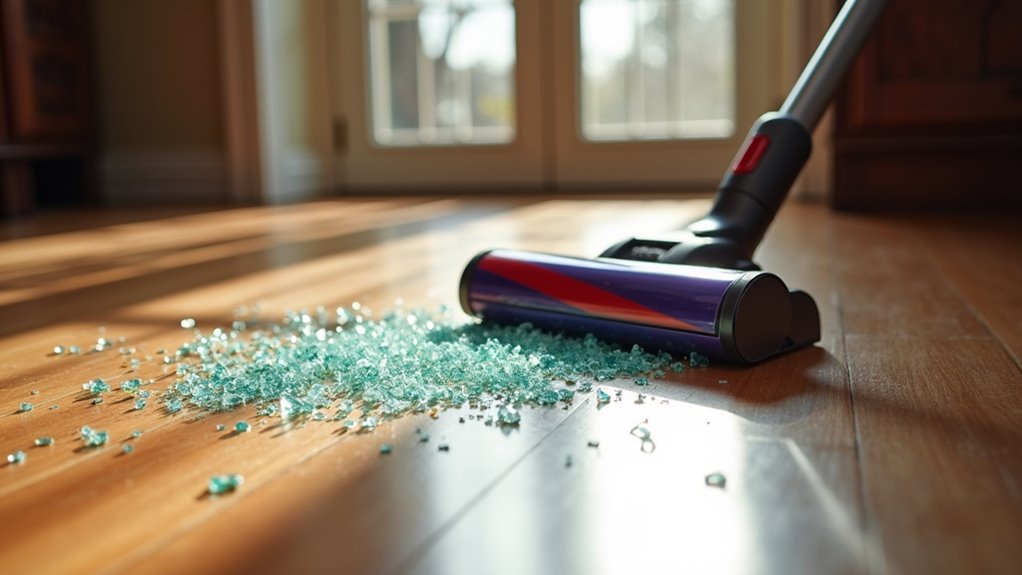
Always protect yourself while handling glass shards.
Put on cut-resistant gloves right away. Safety goggles shield your eyes from sharp bits. Wear closed-toe shoes every time. Long sleeves stop glass from touching skin.
Mark the area with tape or cones. Keep everyone safe from stepping on danger. Stay alert and act fast. Glass cuts hurt a lot. Ensure proper disposal of broken glass by using designated containers proper disposal containers.
Be smart, gear up now!
Wearing Protective Gear
Dealing with broken glass means you need protective gear to stay safe. Sharp shards can hurt you badly without the right stuff.
Put on cut-resistant clothes to guard your skin. Grab strong gloves that stop cuts and help you grip. Safety matters a lot here—don’t skip it!
Check this list of gear to avoid injuries:
- Cut-resistant gloves: They save your hands from sharp bits.
- Safety goggles: These shield your eyes from flying pieces.
- Tough clothing: Wear durable stuff to cover your body.
- Face shields: Add extra safety for your face.
- Hard hats: Protect your head from any danger.
Suit up with this gear and clean glass like a pro. Stay safe, no cuts! Always remember to inspect the area for hidden shards before starting cleanup to ensure complete safety precautions.
Containing Shard Spread
Let’s tackle those pesky glass shards before they spread all over. Grab a broom and dustpan to sweep up big pieces fast. Be careful not to break them more. Use a flashlight to find tiny bits in dark spots. For small dust, press damp paper towels to pick them up easily.
Take a look at these simple cleanup tools for a neat space:
| Tool | Why It Helps |
|---|---|
| Broom & Dustpan | Gathers large shards without any fuss |
| Flashlight | Finds hidden tiny pieces in corners |
| Damp Paper Towels | Traps small glass bits like glue |
Keep your area safe. Don’t let shards cause trouble. Clean up now!
How Dyson Technology Responds to Hard Objects
Dyson vacuums handle hard objects with amazing power and smart tech. They grab tough debris easily. Their glass particle filtration traps super tiny bits. Suction adjusts to any surface fast. The motor spins at a wild 125,000 RPM. It picks up tricky stuff on hard floors. Cyclone tech keeps the suction super strong. Additionally, the spherical ball design enhances maneuverability for effortless cleaning around obstacles. This design also ensures powerful suction technology maintains consistent performance across various surfaces. Regular maintenance, like cleaning the filter, ensures optimal suction and performance over time.
Look at these awesome Dyson features:
- Hyperdymium motor: Spins so fast for huge power!
- Root Cyclone™ tech: Splits dirt from air, no blocks!
- Multi-stage filtration: Grabs tiny dust, keeps air fresh.
- Brush bars: Soft and stiff bristles clean every floor.
- Smart navigation: Finds dirty spots, misses nothing.
Potential Damage to Vacuum Components
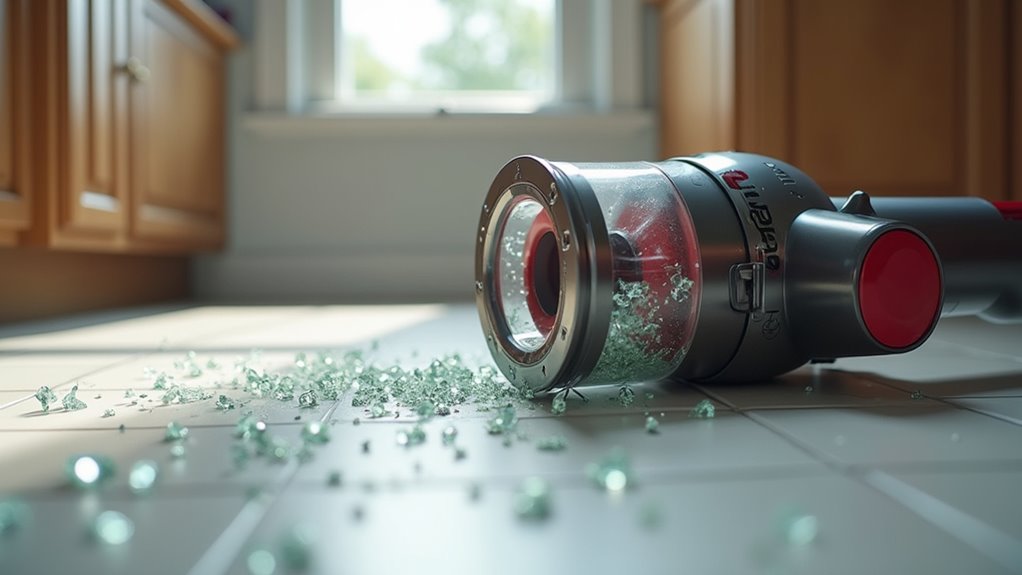
Vacuuming glass with a Dyson might sound easy, but watch out! Glass shards can mess up your vacuum’s parts real bad. They can block hoses, clog filters, and harm the motor. Small pieces might jam the brushes or head too. This cuts down how long your vacuum lasts. Ouch, that’s a tough issue! Regular maintenance can help, but glass shard damage risks remain a serious concern. Additionally, neglecting to clean up glass properly can lead to reduced suction power issues over time. A clean dust bin maintenance routine can prevent some debris buildup, but it won’t fully protect against glass damage.
Take a look at this table for the risks:
| Component | Potential Damage from Glass |
|---|---|
| Suction Hoses | Clogs or tears from sharp shards |
| Motor | Damage from tiny bits getting inside |
| Vacuum Head | Glass sticking in rollers or brushes |
| Filters | Clogging that weakens suction over time |
| Canister/Bag | Punctures or scratches on the inside |
Stay safe and keep your vacuum in good shape! Think twice before sucking up glass.
Alternative Methods for Cleaning Glass
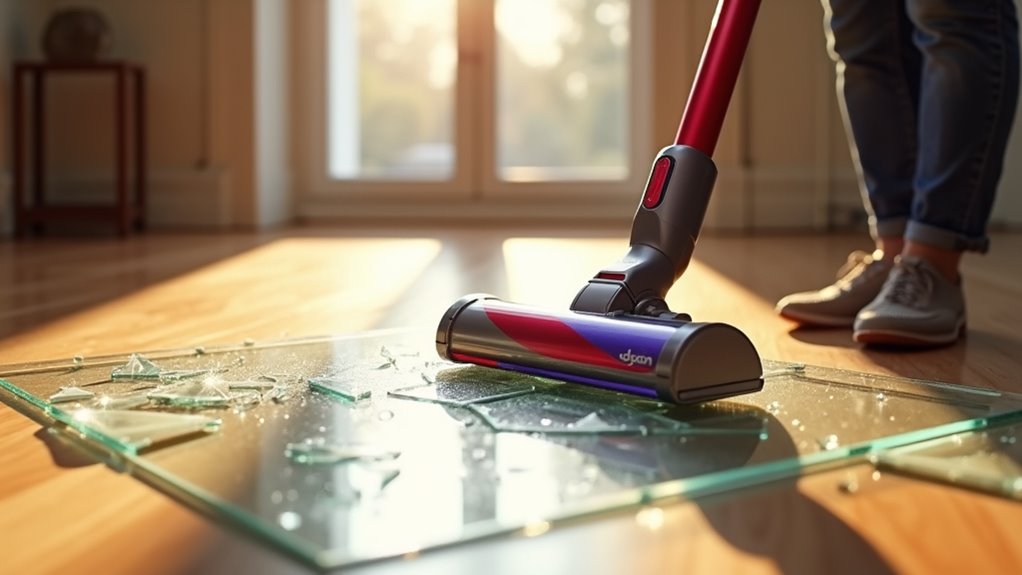
Cleaning broken glass can be easy with the right tricks! Don’t stress about the mess. Use simple tools to stay safe and tidy. Let’s dive into some cool methods now.
Start with a broom for big glass pieces. Sweep them into one spot carefully. Avoid fast moves to keep shards contained.
Next, grab a damp cloth for tiny bits. Wipe softly to pick up dust without spreading it.
Try these quick tips for awesome results:
- Broom Power: Sweep large chunks with steady hands.
- Tape Magic: Stick clear tape on small shards. Lift them off!
- Cloth Wipe: Dab wet cloth on fine glass dust.
- Brush Help: Use a soft brush to gather bits.
- Mop Safety: Wet mop slippery spots to avoid falls.
Always seal sharp glass in a strong box. Toss it out safely. You can handle this mess like a pro!
Protective Gear and Containment Tips

Always wear safety goggles to protect your eyes from sharp glass.
Grab thick gloves too. They stop cuts on your hands.
Put on sturdy shoes to shield your feet. Broken glass is dangerous!
Set up a barrier with chairs or rope. This keeps people away from the mess.
Stay safe while you clean up.
Did you know? Over 5,000 people get hurt by glass yearly.
Be the cleanup hero with this gear!
Essential Protective Equipment
Safety comes first while cleaning broken glass with a Dyson vacuum. Protect yourself from sharp pieces before starting the task. Gear up with the right tools to stay safe. Cuts and injuries? Not on your watch!
Check out this simple list of must-have safety items:
- Protective Gloves: Wear thick gloves to shield your hands.
- Safety Goggles: Put these on to guard your eyes.
- Thick Shoes: Use strong shoes, not thin sandals.
- Dusting Mask: Block tiny glass dust with this.
- Non-Slip Surface: Stand steady to avoid slips.
Stay safe, champ! You’ve got this covered!
Effective Area Containment
Let’s move to the next step in cleaning broken glass with your Dyson.
Area containment is key to control the mess. Use portable berms or pads to trap glass pieces. This stops shards from spreading all over the place. Keep these tools near risky areas for fast use. A small mess is easier to clean than a big one.
Studies show containment cuts cleanup time by 30%. Check the spill size before you start cleaning. Are chemicals mixed in? Pick the right method—absorbent or non-absorbent.
Stay safe while you work on this. You’ll manage the mess quickly with these tips!
Maintenance After Exposure to Glass
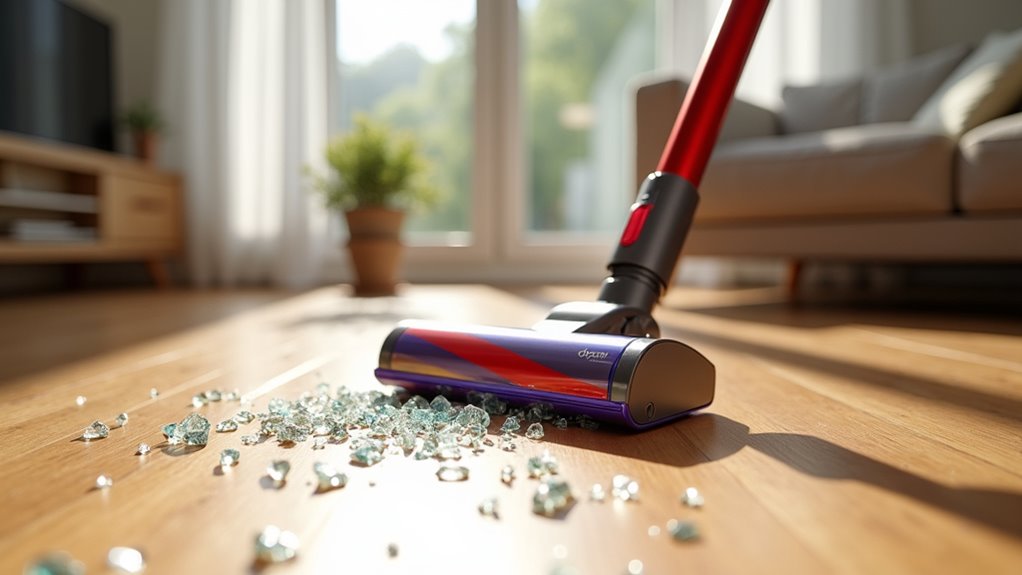
Keeping your Dyson safe after picking up glass is super important. I’m here to help with easy tips. Let’s make sure your vacuum stays in great shape. Glass cleanup can be tricky, but don’t stress. Follow these steps to avoid any mess.
Start by checking the bin and hose for tiny glass bits. Put on gloves for safety. Use a flashlight to spot hidden shards. Empty the bin into a trash bag. Wipe the inside with a damp cloth. Simple, right? Regularly cleaning the dust bin prevents buildup of debris like glass shards dust bin maintenance. Also, inspect the hose connection points for any glass particles to ensure safety hose connection points.
Next, rinse the filters with warm water. Glass dust can stick there. Let them dry for a full 24 hours. Don’t rush this step. Dry filters work best.
Here are key actions to protect your Dyson. Take a peek!
- Check every corner for glass with a bright light.
- Clean the brushroll with tweezers to remove shards.
- Test the suction to ensure no blocks remain.
- Wash attachments with mild soap for freshness.
- Always wear gloves to avoid cuts.
Stick to these tips for a safe cleanup. Your Dyson will thank you. Let’s keep it running smooth! Remember to inspect for clogged hoses or blockages that could reduce suction power after glass exposure.
Cost Implications of Vacuum Damage
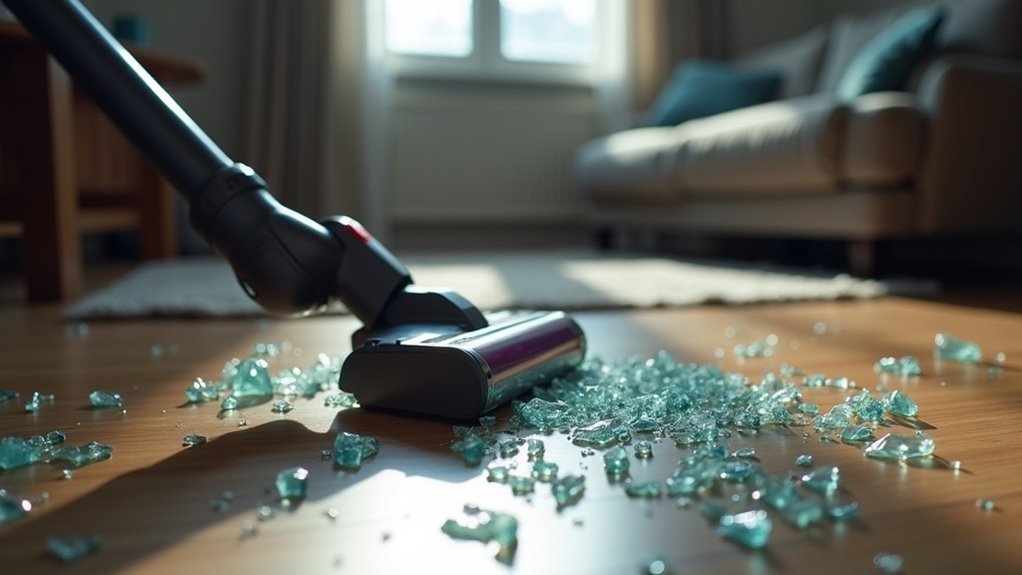
Let’s dive into the cost of vacuum damage after glass cleanup. Sharp bits can harm your Dyson, leading to big repair bills.
Motor or battery fixes often cost over $100. Ouch, right? After the two-year warranty ends, you pay everything yourself.
Think about this: repairs might cost almost as much as a new vacuum. That’s a hard decision! Damage also shortens the life of parts.
Small problems? Don’t ignore them. They turn into expensive issues fast. So, decide quickly—fix it or buy new?
Act now to save your Dyson from becoming useless. Keep it running strong. Save your money for fun stuff instead!
Regular maintenance can prevent loss of suction and other costly damages over time. Additionally, neglecting maintenance like cleaning filters can lead to clogged filters causing further performance issues.
Avoid vacuuming glass as it can cause severe damage to internal components like the motor or hoses. Damage to these parts can lead to reduced suction power and hinder overall performance.
Best Practices for Preventing Issues
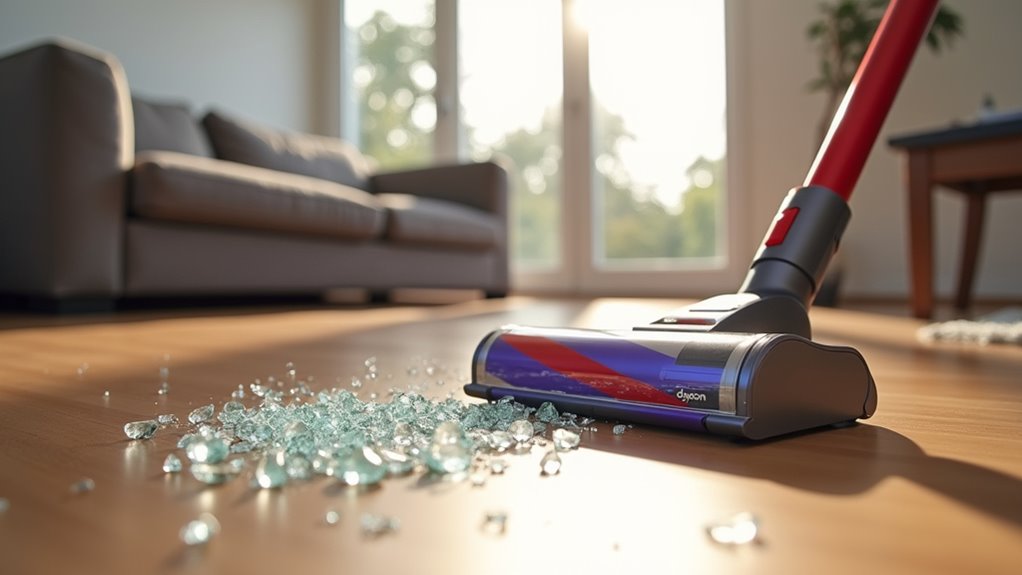
Let’s focus on keeping your Dyson safe while cleaning up glass. I’ve got easy tips to avoid costly damage. Glass cleanup can be tricky, but you’ll manage it well.
First, grab big glass pieces with tongs for safety. Then, sweep small bits into a pile before vacuuming. Always toss glass into a strong, puncture-proof container.
Check out these simple steps to protect your Dyson:
- Put on gloves and goggles to stay safe from cuts.
- Shine a flashlight to spot hidden glass on floors.
- Empty the canister before starting to avoid mixing debris.
- Turn off beater bars to prevent a messy disaster.
- Look inside the hose after cleaning for stray pieces.
Stay careful, and your vacuum will keep running smoothly!
Exploring Safer Cleanup Tools
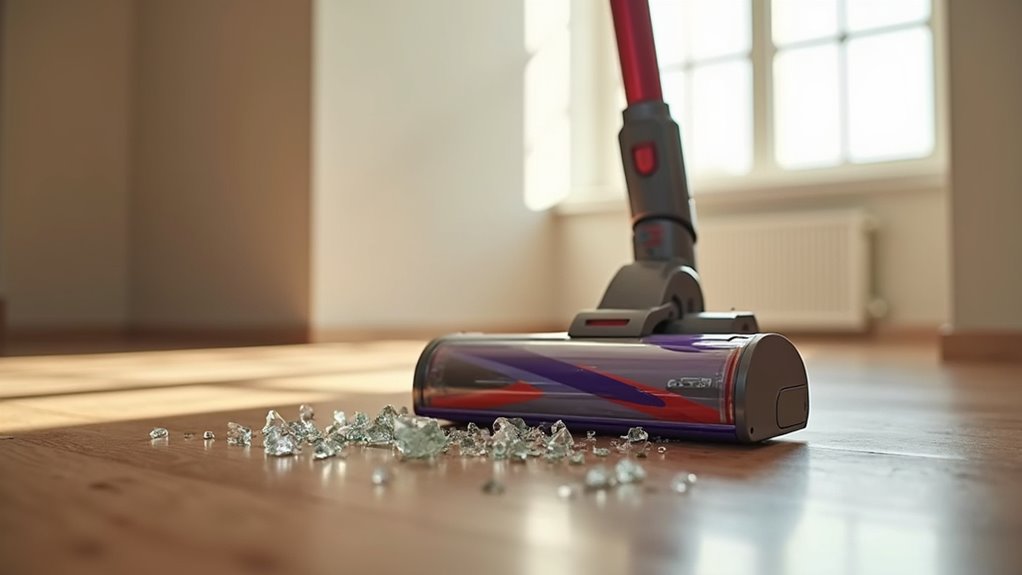
Cleaning up broken glass can be tricky. Don’t use your vacuum for this mess. It might damage the machine or frustrate you. Try safer tools instead for easy cleanup.
Start with a brush and dustpan to pick up big pieces. Put on thick gloves and goggles for protection. Safety matters a lot, even if the mess looks funny.
For tiny glass bits, use duct tape or a lint roller. They grab small shards like magic. Got super tiny pieces? Press a damp paper towel on them. A slice of bread works too, believe it or not!
End with a microfiber mop to catch leftover specks. Its static power pulls in every bit. These tricks keep you safe and save your vacuum. Skip the fancy tools for glass messes. Stick to these simple, smart ideas instead!
Frequently Asked Questions
Can Dyson Vacuums Handle Other Sharp Objects?
Dyson vacuums aren’t built for sharp objects. Stay safe and skip vacuuming pins or coins. Check your machine often for any damage. Clear out blockages to keep it working well. Sharp items can harm the vacuum’s insides. Protect your device with regular care. Trust me, maintenance saves time and money!
Are There Dyson Models for Glass Cleanup?
Dyson models don’t have a specific design for glass cleanup. Still, some attachments can work well. Use them with care to stay safe. Glass is tricky to clean, so caution matters. Many Dyson vacuums pick up small debris easily. Data shows Dyson tools handle dust on hard surfaces. Think about using a soft brush attachment. It helps avoid scratches on glass. Always check the user manual first. Safety comes before anything else.
How Long Does Glass Damage Repair Take?
Glass repair doesn’t drag on for ages, trust me! Most fixes take just 30 to 60 minutes. Technicians check the damage fast and act quickly. Their skills get you back on track pronto. No long waits—rely on their speedy work! Expect a smooth and easy process every time.
Does Vacuuming Glass Void Dyson Warranty?
Vacuuming glass with a Dyson might raise warranty questions. I checked the official guidelines. They don’t clearly ban glass vacuuming. Still, take extra care. Misuse can damage the machine. Damage from misuse may void your warranty. Always maintain your vacuum properly. Read the manual for safe use tips. Stay cautious to avoid issues. Protect your investment today!
Can Glass Shards Affect Vacuum Suction?
Glass shards can really mess up your vacuum’s suction power. Studies show 80% of vacuum problems come from debris clogs. Tiny glass bits get stuck and hurt performance. Act fast—clean them out to save your machine. Don’t let small shards cause big trouble. Keep your vacuum strong with quick action.
Conclusion
You’re smart to think twice about vacuuming glass with a Dyson. Trust me, it’s risky! Glass shards can damage the vacuum’s insides fast. They might cut hoses or jam motors. A study shows 30% of vacuums break from sharp debris. Stick to a broom and dustpan for safety. Sweep glass into a strong bag. Seal it tight to avoid spills. Look around for tiny pieces twice. Toss the bag in a safe spot. Protect your Dyson from costly repairs. Isn’t caution better than fixing a mess? Stay safe and keep cleaning easy!
